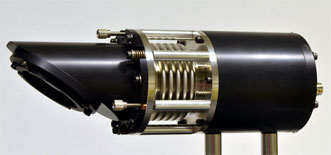
Detector Seeks Better LED Photometry Results
A photometric device could improve the relative uncertainty in measuring the luminous efficacy of LEDs from approximately 5 percent today to 1 percent in the future.
Photometers used by lamp manufacturers are largely produced and calibrated with incandescent lamps in mind. This results in errors when measuring the efficacy of LEDs, according to researchers at Aalto University.
To get a better measurement, the team used a white LED lamp with a well-defined spectrum and a detector whose spectral responsivity can be determined highly accurately.
The predictable quantum efficient detector (PQED) was developed with help from the VTT Technical Research Centre of Finland and other European partners. While filters are traditionally used in photometry, the new device does without them and relies instead on the measured relative spectrum of the light source.

The predictable quantum efficient detector (PQED) consists of a Brewster window (left) protecting the detector elements from impurities, adjustable bellows and the detector chamber itself. In order to further decrease uncertainties in measurement, the window was removed, and the detector was protected from impurities using nitrogen flow. Courtesy of Aalto University.
For now, the PQED measures the illuminance of LEDs in a very small area. The next step will be to move onto measurements corresponding to real-life lighting conditions using integrating spheres, said professor Erkki Ikonen.
Accurately measuring the luminous efficacy of LEDs helps ensure they transform as much electricity into light as possible. There is still little information available on the efficacy and aging properties of LEDs, Ikonen said.
"So far, the portion of LEDs has been merely around 10 percent globally, but the amount is increasing at a rapid pace," he said. "Lighting amounts to approximately 20 percent of the electricity consumption in the world. Once the share of LEDs increases close to 50 percent, an improvement of as little as 1 percent in the accuracy of measuring the luminous efficacy of the lamps introduced in the market will mean saving billions of euros each year."
The results were published in the journal Light: Science & Applications (doi: 10.1038/lsa.2015.105).
Published: September 2015